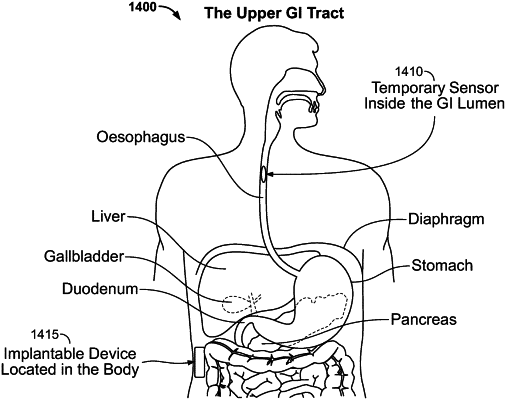| CPC A61N 1/36007 (2013.01) [A61B 5/0031 (2013.01); A61B 5/42 (2013.01); A61B 5/687 (2013.01); A61B 5/6852 (2013.01); A61B 5/6861 (2013.01); A61N 1/0507 (2013.01); A61N 1/36017 (2013.01); A61N 1/36021 (2013.01); A61N 1/36125 (2013.01); A61N 1/36139 (2013.01); A61N 1/36146 (2013.01); A61N 1/36171 (2013.01); A61N 1/36175 (2013.01); A61N 1/37264 (2013.01); A61B 5/03 (2013.01); A61B 5/14539 (2013.01); A61B 5/4836 (2013.01); A61N 1/0517 (2013.01)] | 14 Claims |

|
1. A method of implanting electrodes in a patient in order to treat gastroesophageal reflux disease, comprising:
implanting a first electrode in an anterior proximal wall of an esophagus, wherein said first electrode is positioned axially along a length of said esophagus, wherein said first electrode consists of one contiguous linear member, and wherein said first electrode is configured to apply an electrical pulse train to the patient's lower esophageal sphincter; and
implanting a second electrode proximate a right lateral wall of said esophagus, wherein said second electrode is positioned axially along a length of said esophagus, is positioned parallel and distal to said first electrode, consists of one contiguous linear member, and wherein said second electrode is configured to apply the electrical pulse train to the patient's lower esophageal sphincter.
|
|
8. A method of implanting a first electrode and a second electrode in a patient in order to treat gastroesophageal reflux disease, comprising:
implanting the first electrode in an anterior proximal wall of an esophagus, wherein said first electrode is positioned axially along a length of said esophagus, wherein said first electrode consists of one contiguous linear member, and wherein said first electrode is configured to apply an electrical pulse train to the patient's lower esophageal sphincter; and
implanting the second electrode proximate a right lateral wall of said esophagus, wherein said second electrode is positioned axially along a length of said esophagus, is positioned parallel to and at a same height along said esophagus as said first electrode, consists of one contiguous linear member, and wherein said second electrode is configured to apply the electrical pulse train to the patient's lower esophageal sphincter.
|